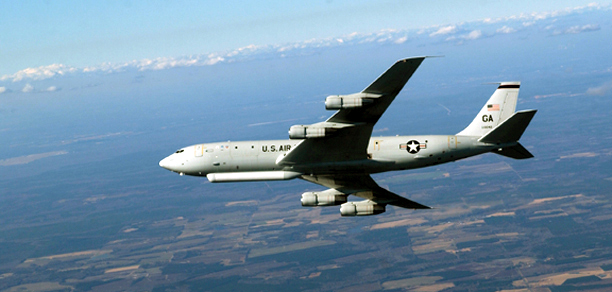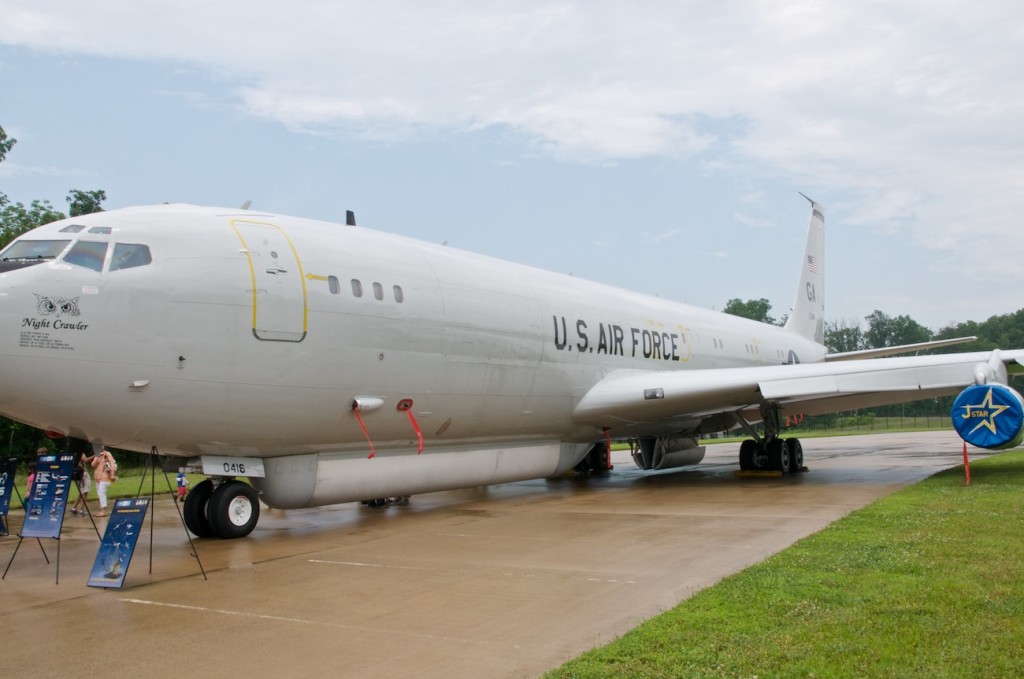What a Difference a Hole Makes: E-8C JSTARS $7.35 million Radar Mishap
While washing a USAF Northrop Grumman E-8C JSTARS at a the Northrop Grumman Lake Charles Maintenance and Modification Center in Louisiana, maintainers covered up three drain holes in the 40 ft (12 m) canoe-shaped radome. This houses the 24 ft (7.3 m) APY-7 passive electronically scanned array Side Looking Airborne Radar (SLAR) antenna fitted to the heavily modified Boeing 707-300 surveillance aircraft.
So far so good…
Unfortunately these were not uncovered afterwards says a Air Force Materiel Command (AFMC) Accident Investigation Board (AIB) report. It is reported that:
…maintainers were required to make sure the drain holes weren’t obstructed as part of the pre-flight inspection process… But pre-flight inspections were conducted four times [at Lake Charles]…without catching the drain hole obstructions. The damage wasn’t caught until the JSTARS was flown back to Robins and maintainers there conducted their own inspection.
The AIB describe this as being due to a “checklist error”. Consequently 4.5 in (114 mm) water collected in the radome between 4 June and 27 July 2016.
On 25 June 2016, Northrop personnel powered the aircraft’s radar as part of maintenance procedures, cycling the antenna. The combination of electrical current and moisture exposure led to the degradation and damage of many of the antenna’s components, to include 240 circuit cards.
Four other aircraft were subject to inspections. It was later reported that one management change had been made at the lake Charles facility. It was commented that:
…problems stem at least partially with the Air Force’s confusion over when and if to retire JSTARS. When the service planned to retire the fleet, it kept aircraft from moving into depot maintenance, believing that no further work would be needed before they were mothballed. However, after it decided to keep operating JSTARS, a higher number of planes than expected were rushed to the depot [creating an]…unexpected demand.
Oversight processes had also been relaxed, so maintenance work was not as heavily scrutinized as it had been on previous contracts. …the Air Force has since added some layers of inspections, while Northrop improved training and quality control processes. The parties also modified the incentive structure on the contract to balance capacity and quality, which had languished.
As we had gone through trying to get more airplanes through the depot, we had kind of shifted the incentive to be more on how fast we were able to get them through. Never was it anybody’s intentions … on the part of any of us to sacrifice quality for speed, but unfortunately I think we saw some of that.
Other Safety Resources
- Professor James Reason’s 12 Principles of Error Management
- Back to the Future: Error Management
- Safety Performance Listening and Learning – AEROSPACE March 2017
- Maintenance Human Factors: The Next Generation
- Airworthiness Matters: Next Generation Maintenance Human Factors
- Lost Tool FODs Propeller Blade, Penetrating Turboprop’s Fuselage
- Micro FOD: Cessna 208B Grand Caravan Engine Failure & Forced Landing
- B1900D Emergency Landing: Maintenance Standards & Practices
- Robinson R44 Power Loss: Excessive Lubricant
- United Airways Suffers from ED (Error Dysfunction)
- USAF RC-135V Rivet Joint Oxygen Fire: A military accident investigation has paradoxically determined that a $62.4mn fire was due to a maintenance error but that no human factors were involved.
- Inadequate Maintenance, An Engine Failure and Mishandling: Crash of a USAF WC-130H
- Inadequate Maintenance at a USAF Depot Featured in Fatal USMC KC-130T Accident
- USAF F-16C Crash at Joint Base Andrews: Engine Maintenance Error
- USAF Engine Shop in “Disarray” with a “Method of the Madness”: F-16CM Engine Fire
- MC-12W Loss of Control Orbiting Over Afghanistan: Lessons in Training and Urgent Operational Requirements
- Meeting Your Waterloo: Competence Assessment and Remembering the Lessons of Past Accidents: No one was injured in this low speed derailment in London after signal maintenance errors but investigators expressed concern that the lessons about maintenance errors from the fatal triple collision at Clapham in 1988 may have been forgotten.
- UPDATE 13 March 2019: USAF Tool Trouble: “Near Catastrophic” $25mn E-8C Fuel Tank Rupture
- UPDATE 30 October 2019: ‘Crazy’ KC-10 Boom Loss: Informal Maintenance Shift Handovers and Skipped Tasks
- UPDATE 8 April 2020: NTSB Confirms United Airlines Maintenance Error After 12 Years
Aerossurance worked with the Flight Safety Foundation (FSF) to create a Maintenance Observation Program (MOP) requirement for their contractible BARSOHO offshore helicopter Safety Performance Requirements to help learning about routine maintenance and then to initiate safety improvements: Aerossurance can provide practice guidance and specialist support to successfully implement a MOP.
Aerossurance can provide practice guidance and specialist support to successfully implement a MOP.
As one article, Retired Air Force Four-Star: How to Solve Aviation Crisis has discussed:
…the best solution is for senior officials to keep the door open and have ongoing conversations on potential problems. “It’s not as much oversight as much as it is … going out and talking with [individuals] … just seeing what’s going on…”
Aerossurance is pleased to be both sponsoring and presenting at a Royal Aeronautical Society (RAeS) Human Factors Group: Engineering seminar Maintenance Error: Are we learning? to be held on 9 May 2019 at Cranfield University.
E-8 JSTARS Background
The E-8C Joint Surveillance Target Attack Radar System, or Joint STARS, is an airborne battle management, command and control, intelligence, surveillance and reconnaissance platform. It evolved from US Army and Air Force programmes to develop, detect, locate and attack enemy armor at ranges beyond the forward area of troops. The first two developmental aircraft deployed in 1991 to Operation Desert Storm in the Middle East and then supported Operation Joint Endeavor in the Balkansn December 1995. The APY-7 antenna can develop a 120-degree field of view covering nearly 19,305 square miles (50,000 square km) and is capable of detecting targets at more than 123 nm (250 km). The aircraft are operated by th 116th Air Control Wing at Robins Air Force Base, Georgia.




Recent Comments